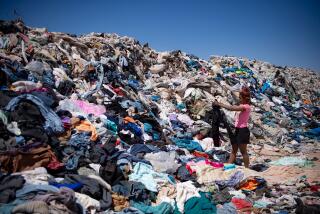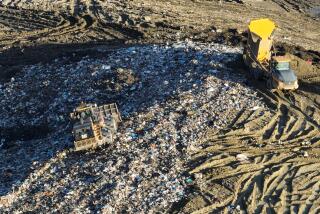Museumâs Exhibits Are Just Plain Trash
LYNDHURST, N.J. â It has to be the trashiest museum in the country.
Most of the exhibits are garbage, and visitors are subjected to an outrageous collection of rubbish. But thatâs the whole point at the nationâs first trash museum, at the Hackensack Meadowlands Environment Center.
âWe wanted to expose people to the growing problem of waste disposal in this country and show them some of the ways they can cope with it,â said center spokesman Robert Grant.
The worsening garbage problem confronts visitors as soon as they enter the first section of the museum building. Resembling a cross between a landfill and a dump, itâs even messier than a teen-agerâs room.
Mounds of old tires and empty bottles line the walls, interspersed with piles of other junk. Thereâs a bit of everything--an old tea kettle, rusting bicycle frames, chicken wire, cereal boxes, milk cartons, even a tired rubber ducky. Overhead, discarded cables, copper tubing and a battered garden hose snake around the ceiling.
Fortunately, one ingredient is missing from this garbage gallery: the smell.
A childish voice emanating from a ceiling speaker tells visitors some facts of life in throwaway America:
âImagine glass, jars and bottles lined up along the highway from New Jersey to California. Thatâs how much glass we use every day. Look at the tires. In one day Americans junk about 400,000 of them. Thatâs a stack 10 times higher than Mt. Everest. And even in New Jersey, where weâre recycling, we still throw away about 10 million tons of garbage a year. If you took 10 million tons and spread it six feet high on a city street, it would reach from here to Atlanta.â
Spreading the word on garbage and recycling is vital in New Jersey, a small but populous state with rapidly vanishing landfills. âThe museum isnât just a gimmick, but a vital education tool in a state where recycling has become mandatory through necessity,â Grant said.
During the school year, about 1,500 children a month visit the museum, which opened in October, 1989. Besides seeing the simulated dump, they learn about recyclable and biodegradable products, play conservation-oriented games and see how landfills operate.
In one room, visitors view an exhibit titled, âWho throws out so much garbage?â They watch a family in a kitchen, doing wasteful things. The faces on the figures are mirrors that reflect the viewersâ own faces.
âEducating kids on recyclables and the growing trash problem is the museumâs strong suit,â said Michael F. DeBonis, a solid-waste-management expert in the U.S. Environmental Protection Agencyâs New York City office. âWe have found kids often play an important part in changing their parentsâ wasteful habits.â
These habits are evident outside the museum, where old landfills, some towering 150 feet, blemish the area. A steady flow of trucks carrying New Jersey trash to other states helps keep the pressure off the one active landfill near the museum. Only about 12 active major landfills remain in New Jersey.
âTo compensate, New Jersey trucks more than half of its garbage to states such as Pennsylvania, Ohio, Illinois and Indiana,â DeBonis said. âNeighboring New York state has become a big trash exporter, too. There is only one landfill left for New York City, and Long Island has only about six remaining.â
Trucking trash is expensive. âIt averages about $100 a ton for garbage thatâs going out of state and can cost as much as $137 a ton,â said Aletha Spang, administrator of New Jerseyâs recycling office. âWe hope to cut our overall costs by recycling as much as 60% of our trash in the next few years.â
New Jersey has shown that even closed landfills can be recycled. Linked by 19,500 feet of pipelines, three old garbage mounds not far from the museum will soon provide enough methane gas for 10,000 homes. The methane, produced by decomposing material in the landfills, is processed to remove impurities and fed into a power companyâs pipeline.
A scenic hill just in front of the museum proves that old landfills can be both attractive and practical. Thousands of trees, shrubs and flowers have been planted on four acres of an old dump there. Strolling the crushed-brick pathways, visitors have a striking view of the Manhattan skyline.
More important, the parkland reinforces the museumâs recycling message in an outdoor setting. About 440,000 plastic soda bottles form part of the synthetic liner that caps the landfill. Trash containers are made from plastic milk bottles, and backfill comes from composted sewage sludge.
More to Read
Sign up for The Wild
Weâll help you find the best places to hike, bike and run, as well as the perfect silent spots for meditation and yoga.
You may occasionally receive promotional content from the Los Angeles Times.






